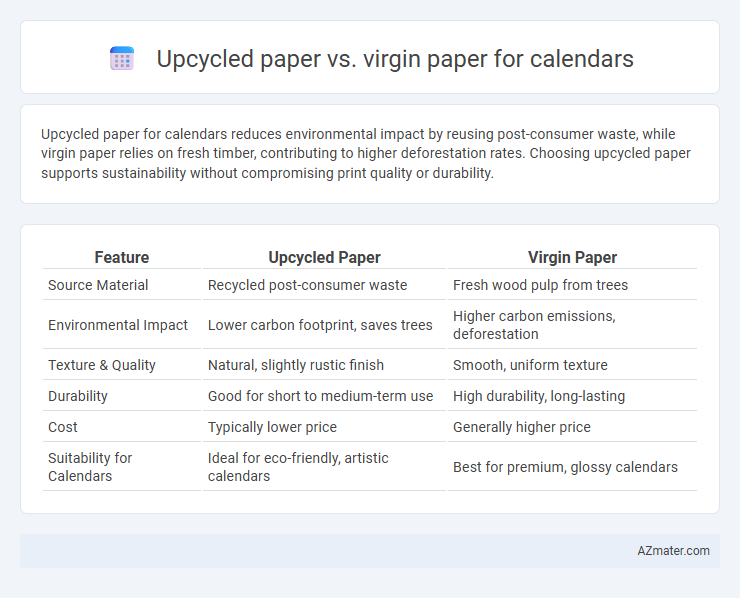Upcycled paper for calendars reduces environmental impact by reusing post-consumer waste, while virgin paper relies on fresh timber, contributing to higher deforestation rates. Choosing upcycled paper supports sustainability without compromising print quality or durability.
Table of Comparison
| Feature | Upcycled Paper | Virgin Paper |
|---|---|---|
| Source Material | Recycled post-consumer waste | Fresh wood pulp from trees |
| Environmental Impact | Lower carbon footprint, saves trees | Higher carbon emissions, deforestation |
| Texture & Quality | Natural, slightly rustic finish | Smooth, uniform texture |
| Durability | Good for short to medium-term use | High durability, long-lasting |
| Cost | Typically lower price | Generally higher price |
| Suitability for Calendars | Ideal for eco-friendly, artistic calendars | Best for premium, glossy calendars |
Introduction: The Calendar Paper Dilemma
Choosing between upcycled paper and virgin paper for calendars involves weighing environmental impact and quality. Upcycled paper reduces waste by reusing existing fibers, lowering carbon emissions and resource consumption significantly compared to virgin paper, which requires fresh tree pulp and more intensive processing. Quality differences affect print clarity and durability, with virgin paper often offering smoother finishes, while advances in upcycled materials increasingly meet professional standards.
What Is Upcycled Paper?
Upcycled paper is created by repurposing waste paper products and discarded materials without breaking them down into raw pulp, significantly reducing environmental impact. Compared to virgin paper, which is made from freshly harvested wood fibers, upcycled paper conserves natural resources, lowers energy consumption, and decreases landfill waste. Using upcycled paper for calendars not only promotes sustainability but also supports eco-friendly manufacturing processes with a smaller carbon footprint.
Understanding Virgin Paper Production
Virgin paper production involves processing fresh wood fibers harvested directly from trees, providing a smooth texture and high durability ideal for calendar printing. This process consumes significant natural resources, including water and energy, and emits greenhouse gases during pulping and bleaching stages. Choosing virgin paper for calendars ensures vibrant colors and long-lasting quality but comes with a higher environmental impact compared to recycled alternatives.
Environmental Impact: Upcycled vs Virgin Paper
Upcycled paper for calendars significantly reduces environmental impact by minimizing deforestation, lowering energy consumption, and decreasing greenhouse gas emissions compared to virgin paper production. Virgin paper requires harvesting fresh wood fibers, contributing to habitat loss and high water usage, while upcycled paper repurposes existing materials, conserving natural resources and reducing landfill waste. Choosing upcycled paper helps promote sustainable practices and supports circular economy principles in paper manufacturing.
Quality and Aesthetics Comparison
Upcycled paper offers a unique texture and subtle color variations that enhance the visual appeal of calendars, creating a distinct rustic or eco-conscious aesthetic. Virgin paper provides a smoother surface with sharper print clarity and consistent whiteness, ensuring vibrant colors and precise image details for high-quality calendar designs. While virgin paper excels in uniformity and brightness, upcycled paper appeals to consumers seeking sustainability with an artisanal look.
Cost Efficiency in Calendar Production
Upcycled paper reduces production costs for calendars by lowering raw material expenses and minimizing energy consumption during manufacturing. Virgin paper involves higher costs due to resource-intensive processes and the use of new pulp, increasing overall budget requirements. Choosing upcycled paper enhances cost efficiency while supporting sustainable production practices in calendar manufacturing.
Print Performance on Upcycled and Virgin Paper
Upcycled paper often contains shorter fibers and more contaminants, which can reduce print sharpness and color vibrancy on calendars compared to virgin paper. Virgin paper, made from fresh pulp, typically offers superior ink absorption and consistent texture, resulting in clearer images and more precise text reproduction. For calendar printing, virgin paper ensures higher print performance with sharper details and brighter colors, while upcycled paper may require adjusted print settings to achieve optimal results.
Consumer Perception and Preferences
Consumers increasingly prefer upcycled paper for calendars due to its sustainable and eco-friendly attributes, viewing it as an environmentally responsible choice. Polls indicate that upcycled paper calendars are perceived as unique and authentic, enhancing brand image and consumer loyalty. In contrast, virgin paper is often associated with higher quality and durability, appealing to consumers prioritizing traditional aesthetics and premium finish.
Sustainability Certifications and Standards
Upcycled paper for calendars often carries certifications like FSC Recycled or Blue Angel, indicating the use of reclaimed fibers and reduced environmental impact, while virgin paper typically holds FSC or PEFC certifications certifying sustainable forest management. Upcycled paper reduces deforestation and energy consumption by repurposing waste materials without sacrificing print quality, meeting standards for recycled content and low emissions. Virgin paper, sourced from fresh pulp, complies with certifications ensuring responsible harvesting but generally has a higher carbon footprint compared to certified recycled alternatives.
Which Paper Is Best for Your Calendar?
Upcycled paper offers an eco-friendly option for calendars, reducing waste and conserving resources, while virgin paper provides higher durability and a smoother finish for vibrant print quality. Choosing between upcycled and virgin paper depends on your priorities: environmental sustainability or premium appearance and texture. For calendars intended as sustainable gifts or promotional materials, upcycled paper is ideal; for luxury or professional settings, virgin paper ensures a refined look.

Infographic: Upcycled paper vs Virgin paper for Calendar
 azmater.com
azmater.com